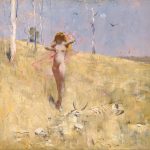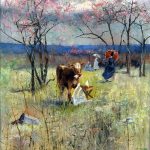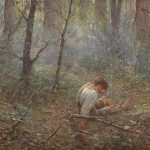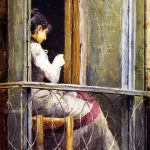Tom Roberts, a seminal figure in Australian art history, was born on March 9, 1856, in Dorchester, Dorset, England. Recognized as one of the leading artists of the Heidelberg School, Roberts played a pivotal role in shaping the trajectory of Australian Impressionism and capturing the essence of the country’s landscapes, people, and culture. His contributions to Australian art earned him a lasting legacy as a key figure in the development of a distinct national identity through art.
Roberts’ family immigrated to Australia when he was just thirteen, settling in the vibrant city of Melbourne. The young artist displayed an early aptitude for drawing, prompting his parents to enroll him at the Collingwood Grammar School. His artistic talents continued to blossom, leading to further studies at the National Gallery School in Melbourne under the guidance of renowned artist Eugene von Guérard.
The late 19th century marked a period of artistic transformation in Australia, and Roberts found himself at the forefront of these changes. Influenced by the principles of Impressionism, particularly as espoused by the French Barbizon School and the Australian artist Arthur Streeton, Roberts became a central figure in the formation of the Heidelberg School. This movement, characterized by its emphasis on plein air painting and a commitment to capturing the unique Australian landscape, sought to break away from the academic conventions prevalent at the time.
In 1883, Roberts traveled to Europe to further his artistic education, studying at the Royal Academy of Arts in London and the Académie Julian in Paris. Exposure to European art and the Impressionist movement, in particular, left an indelible mark on Roberts, influencing his approach to color, light, and the representation of everyday scenes.
Upon returning to Australia in 1885, Roberts, along with fellow artists Arthur Streeton and Charles Conder, established the Box Hill artists’ camp, a precursor to the more famous Heidelberg artists’ camp. These camps became crucibles for the development of Australian Impressionism, fostering a sense of camaraderie and collaboration among the artists.
One of Roberts’ most iconic paintings emerged from this period – “Shearing the Rams” (1890). This monumental work, depicting shearers laboring in a shearing shed, is celebrated for its dynamic composition, use of light, and a keen sense of the Australian rural experience. “Shearing the Rams” is regarded as a defining image of the national character and has become an enduring symbol of Australian art.
The Heidelberg School, also known as the Australian Impressionists, embraced the practice of painting outdoors directly from nature, capturing the vivid colors and light of the Australian landscape. Roberts’ ability to convey the harshness and beauty of the Australian bush and rural life set him apart as a leading proponent of this movement.
Roberts’ leadership extended beyond his artistic contributions. He played a crucial role in organizing the famous “9 by 5 Impression Exhibition” in 1889, where artists, including Roberts himself, exhibited small-scale works on cigar-box lids. This exhibition was a bold departure from traditional art displays and marked a significant moment in the promotion of Australian Impressionism.
In 1891, Roberts married Elizabeth Williamson, and the couple traveled to England. While in England, Roberts continued to paint and exhibited his works at the Royal Academy. His experiences in England reinforced his commitment to portraying uniquely Australian subjects and landscapes upon his return.
The turn of the century brought changes to Roberts’ artistic style. He began to experiment with a more traditional approach, incorporating elements of academic art and moving away from pure Impressionism. This shift was evident in works like “The Big Picture” (1903), a grand-scale painting commissioned for the opening of the first Australian Parliament in Canberra. While the painting showcased Roberts’ technical skill, it also signaled a departure from the radical approach of his earlier Impressionist works.
In addition to his artistic pursuits, Roberts was actively involved in art education and advocacy. He played a key role in the formation of the Victorian Artists’ Society and later became its president. Roberts believed in the importance of fostering a supportive artistic community and encouraging the growth of Australian art.
Roberts’ commitment to Australian art was recognized when he was appointed as the first official war artist for Australia during World War I. His paintings from the frontlines captured the poignant and human aspects of the conflict. Roberts’ wartime works reflected his continued commitment to using art as a means of conveying the stories and emotions of a nation.
Despite his significant contributions to Australian art, Roberts faced financial challenges throughout his life. He worked as a teacher, contributed articles to art journals, and undertook portrait commissions to sustain his artistic endeavors. However, financial difficulties persisted, emphasizing the broader challenges faced by artists in establishing themselves in a developing cultural landscape.
Tom Roberts passed away on September 14, 1931, leaving behind a profound legacy that reverberates through Australian art. His contributions to the Heidelberg School, his iconic paintings that celebrate the Australian landscape and culture, and his role in shaping the trajectory of Australian art make him a revered figure in the nation’s artistic history.






